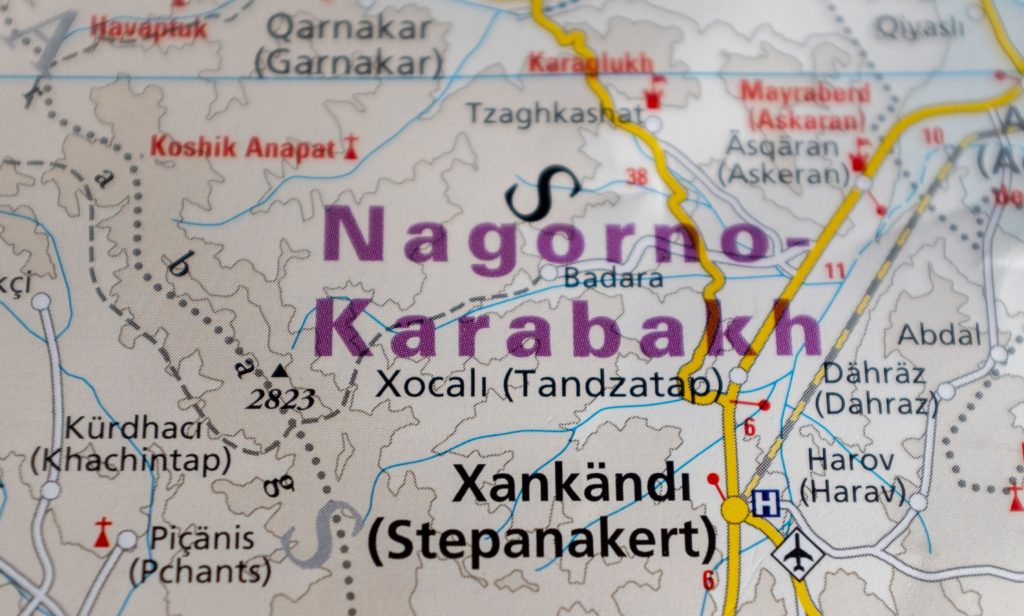BAKU
by LADA YEVGRASHINA
On Sunday, Azerbaijan’s Foreign Ministry acknowledged that Armenia had produced long-demanded maps of minefields in at least one key part of formerly Armenian-occupied regions.
In an apparent exchange, Baku said it had transferred 15 detained people to Armenia. It had claimed previously any individuals it held were not POWs as they were captured after a Russian-brokered November 10 armistice, but instead criminals who were apprehended on its territory. Armenia has said they were workers demarcating the border, which is a major subject of controversy between the two countries.
There was no immediate comment on the landmine maps from Yerevan or in any major press outlet in the country, though the release of the 15 detainees was hailed.
Azerbaijan’s foreign ministry said the maps regarded the heavily mined Agdam region, near the original front lines established in 1994 after Armenian forces took over the area and forced locals to flee.
It said there were – in that region alone – a staggering 97,000 landmines, the locations of which Yerevan had disclosed.
That would mean significantly more landmines in that one district than the original pre-war human population of roughly 60,000.
“According to the agreement reached, on June 12, 2021, in exchange for Armenia’s provision of maps with the location of 97 thousand anti-tank and anti-personnel mines in the Aghdam region on the Azerbaijani-Georgian border with the participation of Georgian representatives, 15 arrested Armenians were handed over to the Armenian side,” the ministry said. Georgia has long tried to balance relations between its two neighbours, Azerbaijan and Armenia or act as a de facto mediator.
In assisting with this issue, the ministry noted the role of the Georgian government, the U.S. Secretary of State, the President of the EU Council and the Swedish chairmanship of the Organisation for Cooperation and Security in Europe (OSCE).
The statement’s wording suggested highlighting the Swedish role, not the OSCE specifically, which Azerbaijan has long derided as ineffective.
The statement went on to say, “We appreciate the support of the Georgian government headed by the Prime Minister of Georgia Irakli Garibashvili in carrying out this humanitarian action.”
Baku also thanked the United States and the European Union.
“At the same time, we emphasise the role of the U.S. Assistant Secretary of State for European and Eurasian Affairs Philip Riker led by U.S. Secretary of State Anthony Blinken.
[And] “the role of the President of the European Council, Charles Michel,” who had spoken to the sides in recent days.
Obtaining landmine maps may help defuse some tensions.
…”The health of tens of thousands of citizens, including sappers, and will accelerate the implementation of the project on the restoration and return of internally displaced persons launched in Aghdam,” the Azerbaijani Foreign Ministry said in a press release.
Mines have killed at least 25 Azerbaijanis and injured more than 100 since Armenia was driven out of the occupied territories or forced to leave others it held under the terms of the November Russian-brokered armistice.
Yet some commentators were sceptical and suspicious of the landmine maps.
Political scientist and MP Rasim Musabekov told the Tribune: “It is essential that Armenia gave Azerbaijan maps of minefields in the Agdam area, one of the most heavily fortified. But this is not a complete solution to the problem. During the 44-day war last autumn, tens of thousands of shells and rockets were fired in this sector of the Karabakh region. A significant part of them remained unexploded in the fields. And even with a map of the minefields of the Agdam region in hand, de-miners will still have a lot of work.”
“This can be considered a diplomatic victory for Azerbaijan. It is also important that the peace agreements’ implementation has moved to the regional context since Georgia joined the process. That is, the countries of this region should solve the region’s problems, which is important. ”

